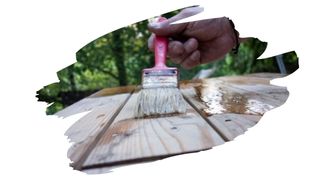Spar Urethane is one of the best ways to weatherproof exterior wood.
Between its durability and its water-resistance, this wood sealer is popularly used on outdoor decking and garden furniture.
So, if Spar Urethane is so durable, why wouldn’t you use it to seal over any shellac finish?
Well, in this post, you’ll learn the difference between dewaxed and waxed shellac — and what it means for Spar Urethanes adhesion to this natural wood finish.
You will also find out whether Spar Urethane really is durable enough to seal and protect that shellac coat.
And keep reading to discover why Shellac isn’t a suitable finish for exterior wood.

This post may contain affiliate links to products that we receive a commission for (at no additional cost to you). Learn more here.
Does Shellac Waterproof Wood All That Well?
Well, shellac is a naturally waxy substance. And it is that waxiness that allows it to be fairly water-repellent.
But, it is not waterproof — and arguably it isn’t even all that water-resistant either.
Instead, this wood finish is very brittle and easily scratched. What’s more, it can become damaged if any alcohol or ammonia gets onto it.
And, on top of all of that, it can start to ‘blush’ and become cloudy if water condensation gets into it.
In other words, shellac is a fantastically glossy finish — but it isn’t going to do much to protect wood from water-damage, dings, and dents.
Got It. So I Should Top Coat It. But Can You Even Put A Top Coat On Shellac?
If you want shellac to last, then you should top coat it with a more durable sealer, such as polyurethane.
However, there is one key caveat to this; you can only top coat dewaxed shellac.
Related Post: Is Shellac A Good Finish For Outdoor Furniture?
You see, when it comes to top coat adhesion, dewaxed and waxed shellac are like night and day.
Almost any finish or sealant will stick onto dewaxed shellac. But, next to nothing can cling onto a waxed shellac finished surface.
How Do You Know If Shellac Is Dewaxed Or Waxed? Waxed shellac looks like a cloudy white liquid in the can. While dewaxed shellac looks like a clear amber liquid instead.
So What Do You Recommend To Put On Top Of Shellac?
Stick to applying a non-penetrating wood sealer or finish.
This is one of the reasons why polyurethane works so well as a top coat on shellac. That’s because — depending on the specific brand — this sealant doesn’t need to sink down into wood to work.
Now, oil finishes like Tung oil or Boiled Linseed oil, work best when they can sink right down into wood fibers. But shellac dries and cures into a solid resin.
So that shellac coat will stop any other penetrating finishes from soaking into wood evenly.
On the other hand, urethane-based finishes, such as spray-on Polyurethane or Spar Urethane, will adhere to dewaxed shellac.
Related Post: Can You Really Apply Wood Wax Over Shellac? (Best Practice Revealed!)
Is Spar Urethane Really More Water-Resistant? What’s The Difference Between Spar Urethane And Shellac?
Well, Shellac is naturally sourced, and Spar Urethane is synthetic. But, their main difference is in their durability.
Spar Urethane
Spar Urethane (sometimes referred to as Yacht Varnish) is a urethane-based wood sealant that’s primarily used for exterior wood.
It is so water-resistant that it’s used to seal boat decking, marine-side structures, and outdoor furniture. And often this product comes with added mold-resistant additives and UV-blockers, designed to help weatherproof wood.
Best of all, it is incredibly durable, and able to shrug of scrapes and scratches with ease. In fact, it is so long-lasting, you only need reapply it once or twice a decade.
Shellac
Shellac is a naturally sourced Lacquer finish excreted by the Lac bug (scientifically known as Laccifer lacca).
The female Lac bug secret a resinous clear substance. And that resin is used to make this glossy finish.
Now, in it’s raw pure form, this resin doesn’t really coat onto wood. Yet, once you thin it out using high-proof denatured alcohol, you can apply it onto wood.
However, it is not a durable finish. If high-proof alcohol gets spilled on it, it will dissolve. Water can easily damage it, causing it to blush. And the slightest ding will cause this fragile finish to splinter.
This is why shellac is best suited for interior wooden surfaces.
Related Post: Will Shellac Be Enough To Prevent Unseasoned Wood From Cracking?
Can You Put Spar Urethane Over Waxed Shellac?
No, you can’t, for the same reason why you can’t top coat anything over waxed shellac.
Urethane-based sealants (such as Spar Urethane) will eventually peel right off a waxed Shellac surface.
But, you can apply a non-penetrating Spar Urethane sealer over dewaxed shellac. And, if you stick to using a clear coating Spar Urethane, it won’t dull that Shellac gloss either.
To Wrap Up, Here Are The 3 Key Takeaways From This Post…
- 1). Shellac is a glossy wood finish, but it is not waterproof or even all that durable.
- 2). Shellac can become damaged by water vapor (such as condensation, moisture, etc). And it is fairly easily scratched.
- 3). You can apply a non-penetrating spray-on Spar Urethane over dewaxed shellac. However, it will struggle to adhere to a waxed shellac finish.
References:
Surface treatments of wood by chemically modified shellac: Surface Engineering: Vol 29, No 2 (tandfonline.com)


![Why Are There Bubbles In My Shellac Wood Finish? [+ How To Get Rid Of Them] bubbles in shellac wood finish](https://www.thewoodworkplace.com/wp-content/uploads/2022/10/Banner-499-150x150.jpg)